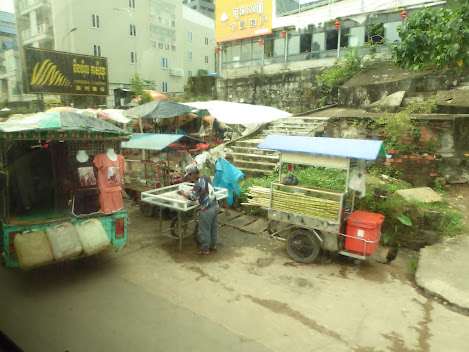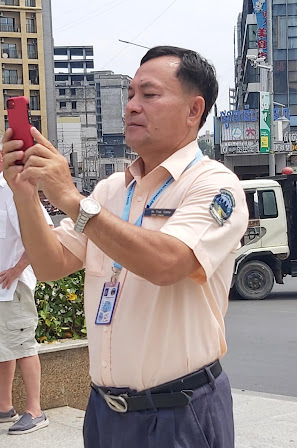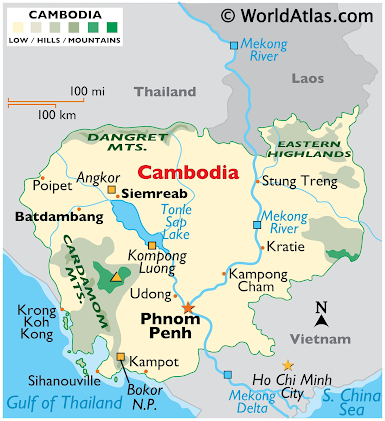They were orphans, those children who followed us around on that hot, humid day in Cambodia.
 |
| We were quite interesting specimens |
As we made our way into temples, and around the grounds of this Buddhist Wat, the children watched us with as much interest as we were showing the statues and buildings that made up this holy place.
Our guide explained as our tour bus pulled away, that the children are being raised and educated within the compound by the monks that oversee its operation.
 |
| The Wat Children - Cambodia |
A collective sigh - the type prompted by learning something heartbreaking - seemed to echo through the bus.as our fellow cruisers processed the information.
 |
| Temples of Cambodia |
The temple compound was our first stop on a tour of Sihanoukville (see-an-oouk-ville), Cambodia, the third port of call on our Southeast Asian cruise. Cambodia was one of the reasons we chose this Oceania cruise. It was all new territory and aside from guidebook descriptions and a few online travel articles most of our ideas about the country had been forged decades ago in our teen years.
 |
| Our welcome to Sihanoukville, Cambodia |
Back in the mid-to-late 70's U. S. newspaper headlines and nightly news reports shaped our view of Cambodia; a country that was then a war zone. Images were furthered cultivated by the chilling, but award-winning 1984 movie called, 'The Killing Fields'.
 |
| 1984 award-winning movie, The Killing Fields |
A capsule bit of history: The Khymer Rouge, a radical communist movement headed by an individual called Pol Pot, ruled Cambodia from 1975 - 1979. He and the Khymer Rouge wanted to socially engineer a classless, agrarian society so took aim at intellectuals, civil servants, professionals and city residents forcing them to march to and work in agricultural fields as part of a re-education process. An estimated 1.5 to 2 million Cambodians died of execution, starvation, disease or of being overworked. Their bodies were buried in mass graves that later became known as the killing fields.
Sihanoukville Today
 |
| Early morning arriving Sihanoukville, Cambodia |
The Sihanoukville cityscape that greeted us in our early morning arrival was breath-taking - it looked both modern and large. And definitely a contrast to those wartime images from 40 years ago.
With just a day to explore this city we chose a highlight's tour which took us to some of the area's famed white sand beaches, the enormous and overwhelming Phsar Leu Market, with booths selling a bit of anything and everything, as well as its famous Golden Lion statues and Buddhist temples.
 |
| The Land of Buddha - Cambodia |
As we traveled between the 'sights', we found the everyday scenes to be as interesting as those places considered 'highlights'. For all the high-rise buildings and big boulevards, hotels and beaches, we also saw poverty.
 |
| Street scenes Sihanoukville Cambodia |
Homes made of corrugated metal, and small roadside businesses being operated off the back of trucks.
 |
| Roadside business - Cambodia |
Seeing local everyday life is one of our favorite travel activities.
 |
| Street scene Sihanoukville, Cambodia |
We saw some beautiful and contrasting sights on that taster-sized tour, but what we will remember the longest about this introduction to Cambodia will likely not be the places we visited, but our tour guide and the story he told in response to that collective sigh about the orphans:
 |
| Our guide - witness to the killing fields |
'Being raised by a Buddhist monk isn't all that bad,' he assured us. 'I was. My sisters and brothers and I were raised by the monks after Pol Pot and the Khymer Rouge killed our parents.'
His father had worked for the government, one of the types of persons targeted by the Khymer Rouge.
 |
| Father of four with an infectious laugh and quick smile |
'I was 10, I remember the march to the fields.'
He then recounted some of the scenes he had witnessed along the way. I am not listing them, suffice to say, they were scenes no one should have to witness, especially a 10-year-old boy and his siblings. He lived with the monks for 10 years.
He didn't tell the story as a victim seeking sympathy. He recounted his experiences candidly. And he balanced the horrors of his childhood, by later telling us of his four college-age children, each on their way to graduation just as any proud dad would. Nor did he dwell on the country's past as he soon resumed his tales and tidbits about Cambodia.
 |
| Cambodia - thanks to WorldAtlas.com maps |
Sihanoukville, also known as Kampong Som, is younger than the two of us. It was 1955 when work began on a deep-water port in an area called Kampong Som and with the port's opening a year later, a town to house the workers was born. It is four-hours from the country's capital, Phnom Penh.
During the course of the day. we were blessed by a Buddhist monk, who prayed and sprinkled holy water on us.
 |
| We were blessed by this monk |
And we were granted good luck (according to legend) because we posed for a photo in front of the Golden Lions Monument on a roundabout from which wide boulevards extend and cars race past. (We had good luck both getting to the monument and back across the street, that is for sure!)
 |
| How lucky are we now! |
Several of our fellow passengers were heard commenting that the city had disappointed them. It had been dirty, there was poverty, and they recounted any number of items that hadn't 'wow-ed' them. We don't travel just to see pretty, so I can tell you that for us, this stop only whetted our appetite for more Cambodia! We are ready to visit Phnom Penh, Angor Wat and Siemreab among others.
That is one of the selling points of cruising for us: these appetizer-sized tastes of places are often enough to bring us back for more comprehensive overland tours or to write a destination off as having 'been there, done that'.
Thanks for being with us today and we hope you'll be back -- and bring some friends with you -- for my upcoming tales of rocking and rolling on the South China Sea thanks to stormy weather!
Until then wishes for safe travels to you and yours~
































